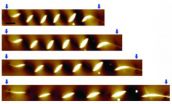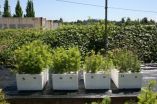NIDCR funding to US dental schools diminished from 2005 to 2009
2011-01-12
(Press-News.org) Adding to the national debate on the state of dental research in U.S. dental schools, an article released today titled "Total NIH Support to U.S. Dental Schools, 2005-2009", published in the International and American Associations for Dental Research's Journal of Dental Research, authors J.A. Lipton and D.F. Kinane conclude that the National Institute of Dental and Craniofacial Research (NIDCR) has played a diminishing role in funding research at U.S. dental schools between 2005 and 2009.
Utilizing the online NIH RePORT, comprehensive award data were obtained for U.S. dental schools from 2005 to 2009. Fifty dental schools were awarded a total of $974.393 million, 69.3 percent from NIDCR and 30.7 percent from 21other NIH Institutes and Centers (ICs). Total NIH funding to dental schools from the NIDCR decreased from 73.6 percent ($147.200 million) in 2005 to 64.9 percent ($131.858 million) in 2009, a 10 percent decrease, while dollars from ICs other than NIDCR increased 34.6 percent between 2005 and 2009. Grants to U.S. dental institutions comprised 50 percent or less of total NIDCR awards globally from 2005 through 2009.
Peter Polverini, Professor and Dean of the University of Michigan Dental School, who recently hosted a workshop for dental deans on the issue of research-oriented dental schools commented on the Lipton and Kinane findings, stated, "if we continue to turn a blind eye to this disturbing trend and dental schools fail to provide faculty with the resources needed to gain a competitive advantage, we run the risk of losing our identity as a profession. . . dental schools and their parent universities must make research and discovery a core value of their mission." He provided these comments in an accompanying perspective article.
AADR President David Wong welcomed the data and call for action from Dean Polverini stating, "we must strengthen the research infrastructure of our nation's dental schools so that the best dental and craniofacial science, particularly translational science, is naturally based in dental institutions."
INFORMATION:
The articles are published in the Journal of Dental Research. To read the abstract of the article by J.A. Lipton and D.F. Kinane, please visit http://jdr.sagepub.com/content/early/2011/01/10/0022034510390215.abstract. Contact Ingrid L. Thomas at ithomas@iadr.org to request PDFs of both articles.
About the Journal of Dental Research
The IADR/AADR Journal of Dental Research is a multidisciplinary journal dedicated to the dissemination of new knowledge in all sciences relevant to dentistry and the oral cavity and associated structures in health and disease. At 4.195, the JDR holds the highest Five-Year Impact Factor of all dental journals publishing original research, with a cited half-life >10 years, reflecting the influential nature of the Journal's content. It also has the highest Eigenfactor Score in the field.
About the International Association for Dental Research
The International Association for Dental Research (IADR) is a nonprofit organization with nearly 12,500 individual members worldwide, dedicated to: (1) advancing research and increasing knowledge to improve oral health, (2) supporting the oral health research community, and (3) facilitating the communication and application of research findings for the improvement of oral health worldwide. To learn more, visit www.iadr.org. The American Association for Dental Research (AADR) is the largest Division of IADR, with nearly 4,000 members in the United States. To learn more, visit www.aadronline.org.
END
ELSE PRESS RELEASES FROM THIS DATE:
2011-01-12
Employees who have to maintain a neutral disposition while they are on the clock tend to spend more energy to meet that requirement; therefore, they have less energy to devote to work tasks, according to new research from Rice University, the University of Toronto and Purdue University.
The researchers found that workers who must avoid appearing either overly positive or negative -- such as journalists, health care professionals, social workers, lawyers and law enforcement officers -- suppress expressions of emotion more than workers in other service-oriented professions, ...
2011-01-12
Researchers at North Carolina State University have created the first coils of silicon nanowire on a substrate that can be stretched to more than double their original length, moving us closer to incorporating stretchable electronic devices into clothing, implantable health-monitoring devices, and a host of other applications.
"In order to create stretchable electronics, you need to put electronics on a stretchable substrate, but electronic materials themselves tend to be rigid and fragile," says Dr. Yong Zhu, one of the researchers who created the new nanowire coils ...
2011-01-12
University of British Columbia researchers are part of European Space Agency's Plank satellite mission that is revealing thousands of "exotic" astronomical objects, including extremely cold dust clouds, galaxies with powerful nuclei, and giant clusters of galaxies.
The international collaboration of scientists from 15 countries is presenting more than 25 scientific papers today in Paris, France, on the first results from the Planck mission. Launched in 2009, the Planck satellite is probing the entire sky at microwave wavelengths from 0.35 millimetre to one centimetre. ...
2011-01-12
WEST LAFAYETTE, Ind. - Purdue University researchers have found a genetic mutation that allows a plant to better endure drought without losing biomass, a discovery that could reduce the amount of water required for growing plants and help plants survive and thrive in adverse conditions.
Plants can naturally control the opening and closing of stomata, pores that take in carbon dioxide and release water. During drought conditions, a plant might close its stomata to conserve water. By doing so, however, the plant also reduces the amount of carbon dioxide it can take in, ...
2011-01-12
In this winter of heavy snows--with more on the way this week--nature's bull's-eye might be Oswego, N.Y., and the nearby Tug Hill Plateau.
There the proximity of the Great Lakes whips wind and snow into high gear. Old Man Winter then blows across New York state, burying cities and towns in snowdrifts several feet high. This season, however, something is standing in his way.
The Doppler-on-Wheels (DOW), a data-collecting radar dish, is waiting. This month and next, scientists inside the DOW are tracking snowstorms in and around Oswego to learn what drives lake-effect ...
2011-01-12
The growing popularity of solar photovoltaic (PV) systems across the United States has made it more important to maximize their power input. That's why UC San Diego environmental engineering professor Jan Kleissl is working on technologies and methods that will better predict how much power we can actually harness from the sun.
In a paper recently published in the journal Renewable Energy (http://www.sciencedirect.com/science/journal/09601481), "Optimum fixed orientations and benefits of tracking for capturing solar radiation in the continental United States," Kleissl ...
2011-01-12
New York, Jan. 11, 2011 -- While scientists believe that climate change and related extreme weather events such as drought and flooding will likely affect the earth's flora and fauna, just how much is not known. A new study by researchers Walter Jetz from Yale University and Dustin Rubenstein from Columbia University however shows an important link between the natural variation in climate conditions and complex behaviors among birds.
The study, which appears in print in Current Biology on Jan. 11, 2011, has implications for understanding how organisms may respond behaviorally ...
2011-01-12
JACKSONVILLE, Fla. — A study by researchers at Mayo Clinic's campus in Florida and Washington University School of Medicine adds a new twist to the body of evidence suggesting human obesity is due in part to genetic factors. While studying hormone receptors in laboratory mice, neuroscientists identified a new molecular player responsible for the regulation of appetite and metabolism.
In the Jan. 11 online issue of PLoS Biology, the authors report that mice engineered not to express the lipoprotein receptor LRP1, in the brain's hypothalamus, began to eat uncontrollably, ...
2011-01-12
The opening of buds on Douglas-fir trees each spring is the result of a complex interplay between cold and warm temperatures during the winter, scientists with the U.S. Forest Service's Pacific Northwest Research Station have found.
Their research—which is featured in the December issue of Science Findings, a monthly publication of the station—led to the development of a novel model to help managers predict budburst under different scenarios of future climate.
"We take it for granted that buds will open each spring, but, in spite of a lot of research on winter dormancy ...
2011-01-12
San Diego, CA, January 11, 2011 – Launched on December 2, 2010, Healthy People 2020 is an ambitious, science-based, 10-year agenda for improving the health of all Americans. A key component, Education for Health, is an educational roadmap to achieve the Healthy People 2020 goals. Formulated by the Healthy People Curriculum Task Force, this set of new and revised educational objectives provides a vehicle for promoting the discussion and progress that will be needed to achieve an integrated, seamless approach to education for health for the American public as well as for ...
LAST 30 PRESS RELEASES:
[Press-News.org] NIDCR funding to US dental schools diminished from 2005 to 2009



